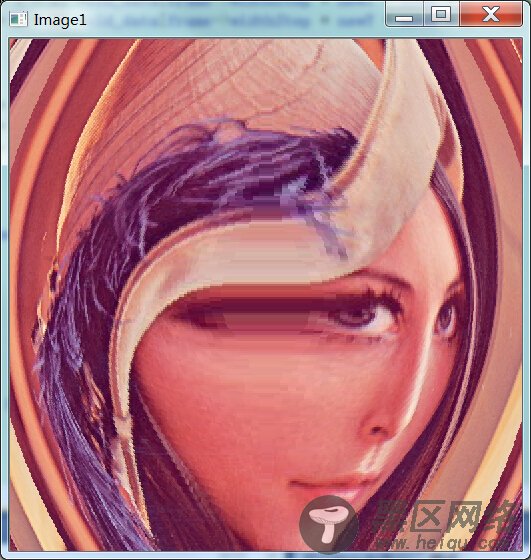OpenCV 实现哈哈镜效果代码,有参考别人的代码
先看实现的效果:

实现效果:

// haha_mirror.cpp : 定义控制台应用程序的入口点。
//
#include "stdafx.h"
#include<iostream>
#include "cv.h"
#include "highgui.h"
#include "math.h"
#include "opencv2/core/core.hpp"
#pragma comment(lib,"opencv_core2410d.lib")
#pragma comment(lib,"opencv_highgui2410d.lib")
#pragma comment(lib,"opencv_imgproc2410d.lib")
#define DOWNRESIZE 0 // 缩小
#define UPRESIZE 1 // 放大
#define HORAO 2 // 水平外凹
#define HORTU 3 // 水平外凸
#define LADDER 4 // 梯形变形
#define TRIANGLE 5 // 三角形变形
#define SSHAPE 6 // S形变形
#define WAVESHAPE 7 // 波浪形变形
#define Concentrated 8 //集中形变形
#define Scattered 9 // 散开形变形
#define RANGE 100 // 水平外凹或外凸的幅度
#define PI 3.1415926
using namespace std;
using namespace cv;
void MaxFrame(IplImage* frame)
{
uchar* old_data = (uchar*)frame->imageData;
uchar* new_data = new uchar[frame->widthStep * frame->height];
int center_X = frame->width / 2;
int center_Y = frame->height / 2;
int radius = 400;
int newX = 0;
int newY = 0;
int real_radius = (int)(radius / 2.0);
for (int i = 0; i < frame->width; i++)
{
for (int j = 0; j < frame->height; j++)
{
int tX = i - center_X;
int tY = j - center_Y;
int distance = (int)(tX * tX + tY * tY);
if (distance < radius * radius)
{
newX = (int)((float)(tX) / 2.0);
newY = (int)((float)(tY) / 2.0);
newX = (int) (newX * (sqrt((double)distance) / real_radius));
newX = (int) (newX * (sqrt((double)distance) / real_radius));
newX = newX + center_X;
newY = newY + center_Y;
new_data[frame->widthStep * j + i * 3] = old_data[frame->widthStep * newY + newX * 3];
new_data[frame->widthStep * j + i * 3 + 1] =old_data[frame->widthStep * newY + newX * 3 + 1];
new_data[frame->widthStep * j + i * 3 + 2] =old_data[frame->widthStep * newY + newX * 3 + 2];
}
else
{
new_data[frame->widthStep * j + i * 3] = old_data[frame->widthStep * j + i * 3];
new_data[frame->widthStep * j + i * 3 + 1] = old_data[frame->widthStep * j + i * 3 + 1];
new_data[frame->widthStep * j + i * 3 + 2] = old_data[frame->widthStep * j + i * 3 + 2];
}
}
}
memcpy(old_data, new_data, sizeof(uchar) * frame->widthStep * frame->height);
delete[] new_data;
}
void MinFrame(IplImage* frame)
{
uchar* old_data = (uchar*)frame->imageData;
uchar* new_data = new uchar[frame->widthStep * frame->height];
int center_X = frame->width / 2;
int center_Y = frame->height / 2;
int radius = 0;
double theta = 0;
int newX = 0;
int newY = 0;
for (int i = 0; i < frame->width; i++)
{
for (int j = 0; j < frame->height; j++)
{
int tX = i - center_X;
int tY = j - center_Y;
theta = atan2((double)tY, (double)tX);
radius = (int)sqrt((double)(tX * tX) + (double) (tY * tY));
int newR = (int)(sqrt((double)radius) * 12);
newX = center_X + (int)(newR * cos(theta));
newY = center_Y + (int)(newR * sin(theta));
if (!(newX > 0 && newX < frame->width))
{
newX = 0;
}
if (!(newY > 0 && newY < frame->height))
{
newY = 0;
}
new_data[frame->widthStep * j + i * 3] = old_data[frame->widthStep * newY + newX * 3];
new_data[frame->widthStep * j + i * 3 + 1] =old_data[frame->widthStep * newY + newX * 3 + 1];
new_data[frame->widthStep * j + i * 3 + 2] =old_data[frame->widthStep * newY + newX * 3 + 2];
}
}
memcpy(old_data, new_data, sizeof(uchar) * frame->widthStep * frame->height);
delete[] new_data;
}

